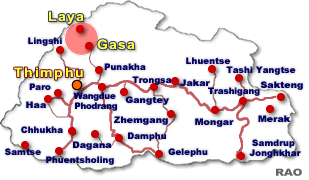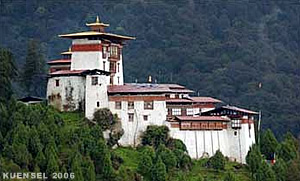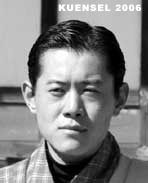 |
Bhutan's
Tourism: Festivals |
|
 |
Bhutan Information |
|
|
 |
| Gasa
is changing - Draft constitution |
 |
 |
| Gasa
is ready to discuss the draft Constitution with His Royal Highness the
Crown Prince, Jigme Khesar Namgyel Wangchuck. They have travelled for
days over the mountains for the meeting to be held on May 13, 2006.
Most
of the people who spoke to Kuensel said that they were there to try and
understand the future. They are optimistic because change has, so far,
been positive. |
|
Ap
Namgay, 82, who was in Punakha, took only seven hours to reach Gasa. The
two hour drive to Goenteygang, followed by a five-hour walk, was a quick
journey. It used to take him four days when he worked there.
 |
The Gasa Tashi Thongmey Dzong
In
2004 the 12 kilometre road from Tashithang was completed and Gasa, the
most remote and least populated dzongkhag, began catching up with the rest
of the country.
When
people working in Gasa could make their first telephone calls in late nineties
they began catching up with the world. On May 7, 2006 , Gasa became the
last dzongkhag to be electrified. Today the people are using rice and curry
cookers. |
|
"The
coming of electricity and the road is changing the lifestyle of Gasaps
and Layaps," said Laya Gup Kinley Dorji. "Because of the road we finished
transporting our year's food rations from Gasa to Laya months ago." So
the Layaps now get two months of extra time to attend to their herds and
work in fields.
 |
| His Royal Highness the Crown Prince, Jigme Khesar Namgyel Wangchuck
The main
town of Gasa, situated at an elevation of 2,770 metres has a dozen
single-storey shops, selling groceries, general goods, and alcohol. The
pride of Gasa, a "standard restaurant, even has a menu.
When
meat is available, a kilogramme of pork costs about Nu. 200. A gas cylinder
costs Nu. 740 and the cheapest vegetable is about Nu. 35 a kilogramme.
Potato is special and can be bought for Nu. 16-18 a kilogramme.
"Groceries
cost twice or three times more than Punakha or Thimphu," said a dzongkhag
employee. "Only the bare necessities are available." |
|
Gasa
has a lower secondary school with boarding facilities, a basic health care
unit, an RNR center, a range office of the Jigme Dorji Wangchuck National
Park, and a BDFC branch office, all within walking distance of the dzong.
Travel
and transportation remain the biggest problem for the people of Gasa. Lunana,
the farthest of the four gewogs, is about eight days' walk. It is covered
by snow for about eight months a year.
The
Lunana community school has not opened yet this year because it is cut
off by snow. "Transporting WFP ration and school textbooks and stationeries
for Laya and Lunana is always a problem for us," said the Gasa dzongkhag
education officer, Wangchuk Dorji.
But
the people of Gasa are not complaining. "We know we will get a road soon
and, sooner or later, we know that Gasa will become like any other town
in the country," said a resident in the heart of Gasa town.
| Contributed
by Ugyen Penjore and Tashi Dorji, Kuensel, Bhutan's National Newspaper,
2006 |
 |
| Information on Bhutan |
 |
|






